Pregnancy is often a woman’s first lesson in flexibility as she approaches motherhood. Despite the best-laid plans, factors like morning sickness and fatigue can make it difficult—if not impossible—to follow an ideal prenatal fitness program. In fact, it is not uncommon for women to have to adjust their programs on the fly, depending on how they feel during each stage of pregnancy.
Of course, every woman is different. While some have to dramatically modify their fitness programs, others continue their normal workouts, including high-intensity activities like running marathons and participating in boot-camp classes. In fact, researchers have discovered that some women can safely continue almost any activity they were participating in before pregnancy throughout most of their pregnancies. While this may be true, all women should pay close attention to how they feel and be prepared to modify their programs accordingly.
Prenatal Precautions
The American Congress of Obstetricians and Gynecologists (AGOC) published their first recommendations on exercise in 1985. Since then, these have been updated in 1994, and again in 2002. You can read the complete current ACOG Guidelines here to learn how to identify absolute and relative contraindications to exercise during pregnancy.
Reasons to discontinue exercise and seek medical advice include:
- Vaginal bleeding
- Sudden swelling of the ankles, hands or face
- Dizziness or faintness
- Persistent, severe headaches and/or visual disturbances
- Chest pain, excessive fatigue or palpitations
- Unexplained abdominal pain
- Calf pain or swelling
- Persistent contractions that may be indicative of preterm labor
- Insufficient weight gain [less than 2.2 pounds (1 kg) per month during the last two trimesters]
- Amniotic fluid leakage
Source: American College of Sports Medicine. (2000). ACSM’s Guidelines for Exercise Testing and Prescription, 6th ed. Philadelphia: Lippincott, Williams & Wilkins.
Additional precautions include:
Hyperthermia
Increases in fetal temperatures from high fevers have been related to birth defects, which initially led doctors to be concerned about elevated body temperatures during exercise. Current research has shown that this is not a major concern, as adaptations that happen during pregnancy and exercise help women regulate their core body temperature more efficiently. Even so, it is still very important to:
- Stay well hydrated
- Avoid exercising in extremely hot and humid temperatures
Not Consuming Enough Carbohydrates
Pregnancy is not the time to think about weight loss. Even when the doctors warn about excessive weight gain, restrictive dieting is not recommended. Pregnant mothers should consume an additional 300 kcal/day and even more if they are exercising regularly. Focus on eating smaller, healthier meals, and eating a healthy pre-exercise snack of protein and carbohydrates.
Supine Hypotensive Syndrome
While lying in the supine position, the additional weight of the uterus during the second and third trimesters can add pressure to the inferior vena cava, thus potentially causing a decrease in venous return to the heart. This can lead to lightheadedness and dizziness. Some research questions the warnings that this position will lead to a decrease in fetal blood supply, but until there is further research, supine exercises—if performed at all—should be done with caution, in very short bouts and with awareness of the feelings of the expecting mother.
Maternal Conditions and Exercises That Can Help
Pregnancy comes with hundreds of aches, pains and unpleasant symptoms. Some people experience almost all of these, while others are fortunate enough that they experience very few. Here are three common aches and pains felt usually during the second and third trimesters and how to use exercise to alleviate them.
Round Ligament Pain
The round ligament, located in the front of the womb, is stretched as baby and uterus grow, which can lead to a sharp jabbing pain in the lower belly or groin area.
Cat Cow
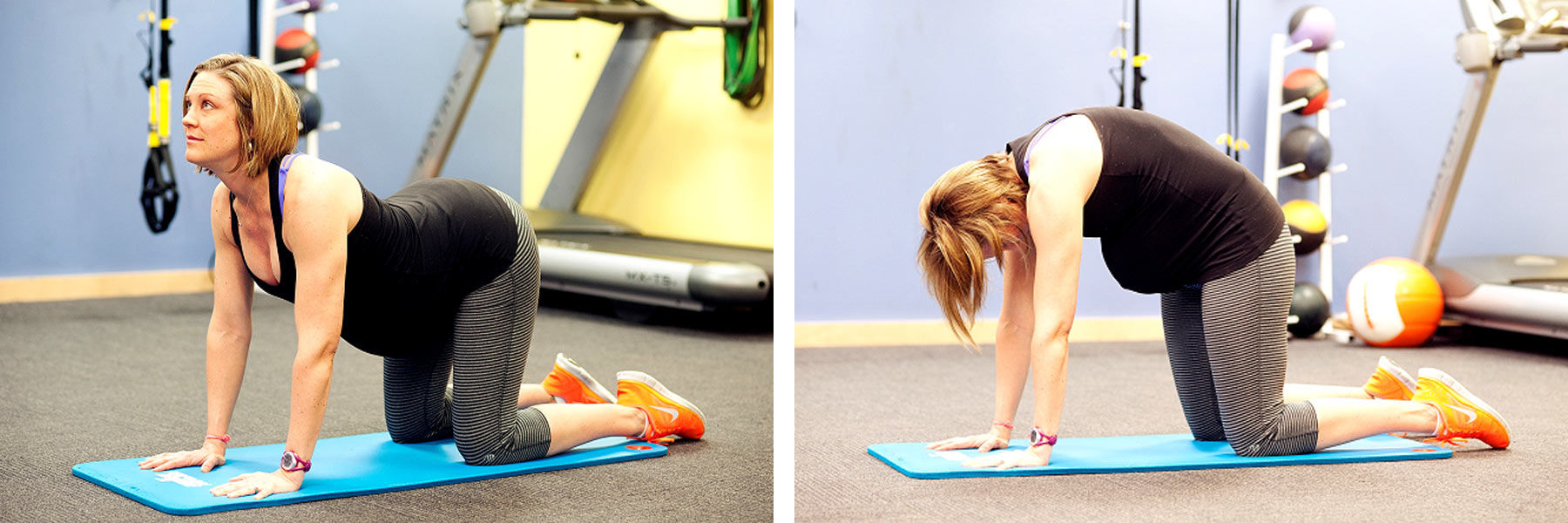
The Cat Cow Pose is a great yoga move to help alleviate round ligament pain. Assume a quadruped (all fours) position with hands pointed forward. Inhale and round the back high, letting the head fall while curling the pelvis under, relieving tension on the ligament. Exhale, pulling the belly toward the mat, and extending the back body wide to stretch the ligament. Repeat 10 times.
Diastasis Recti
The linea alba is the tendinous tissue that merges the rectus abdominal muscles with the fascia. Both the rectus abdominis and the linea alba are designed to contract in a vertical fashion, and are not always able to withstand the strong horizontal pressure put on them with an expanding belly. This can lead to a thinning of the linea alba and a protrusion in the middle of the belly.
Seated abdominal compressions
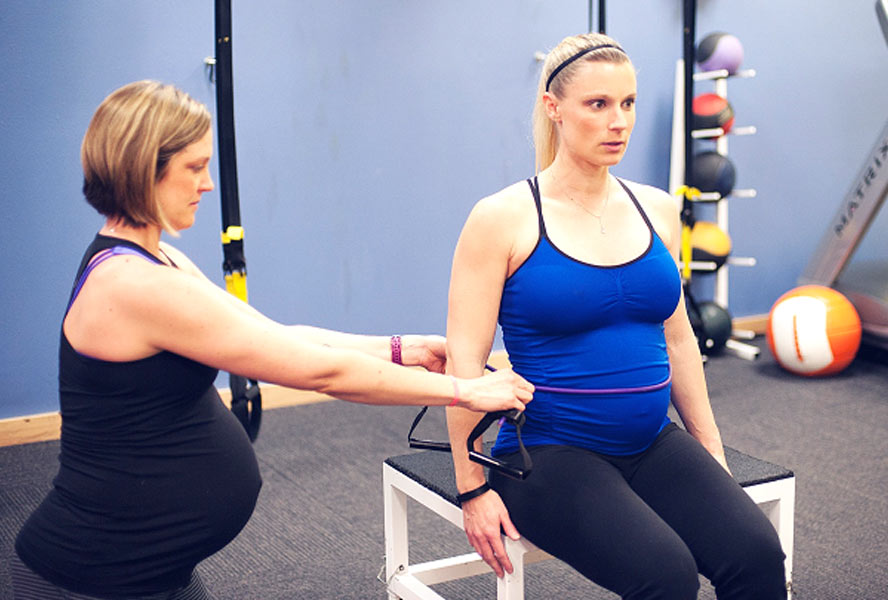
This is a great way to train the transverse abdominals, while also teaching the individual how to engage these muscles.
Have one partner hold a string or band around the stomach of the exerciser. Encourage them to exhale, drawing the navel in and contracting the lower part of the abdominals. As this new tightness is achieved, the partner holding the string will slightly tighten it while the exerciser continues to breathe under this contraction. If the exerciser is having trouble doing the compression correctly, have them make a “ha ha” or coughing sound to encourage the appropriate contraction. Repeat two to three times.
TRX resisted heel taps
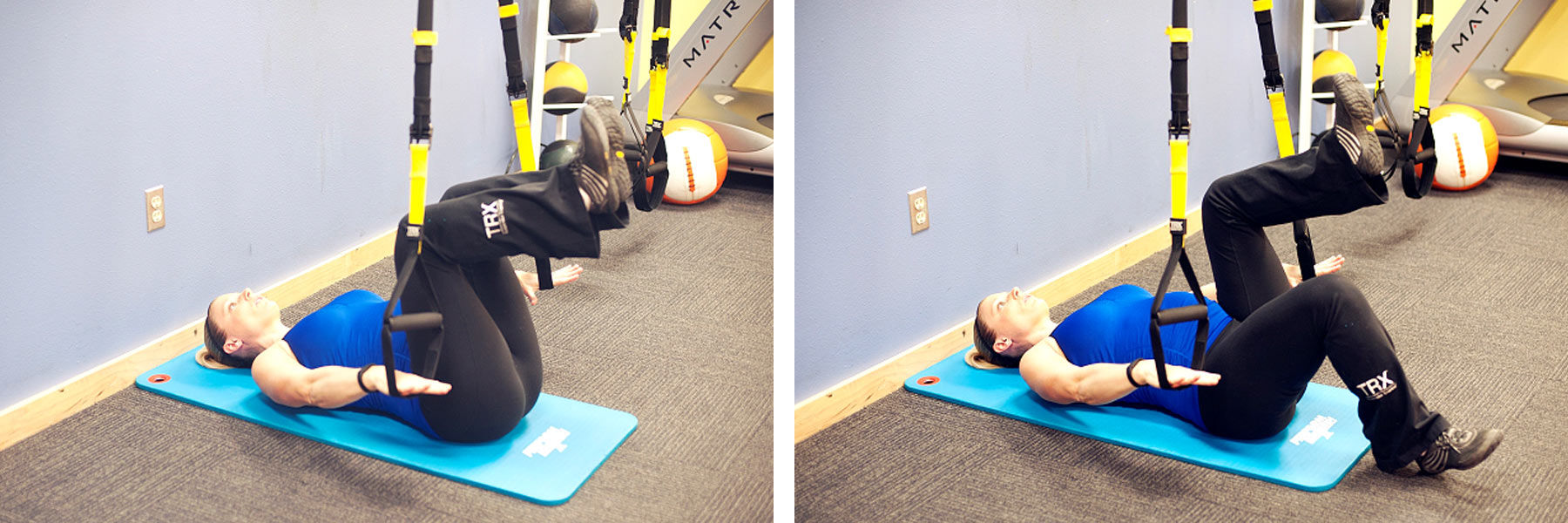
These are another great option. Begin lying on the ground facing the anchor point. Place both hands in the foot cradles and press down. Keep the core braced and knees bent at 90 degrees. Slowly lower one heel toward the ground until just before the low back rises up. Return to the starting position keeping pressure down in the hands. Aim for two 30-second sets of this exercise. (Note: Because this move is performed in the supine position, avoid doing this exercise any longer than 30 seconds and have the exerciser roll to her left side between sets.)
Low-back Pain and Posture Issues
Exercise can ease low back pain for the expecting mother, but if not done properly, it can also aggravate it. Muscles that tend to shorten include the chest, low back, shoulders, hamstrings and calves. Muscles that tend to weaken include the upper back, glutes, abdominals, pelvic floor and quadriceps. Begin by focusing on mobilizing tight muscles, and then work on strengthening weak muscles. Here are some sample exercises:
Seated or Standing Spinal Flexion
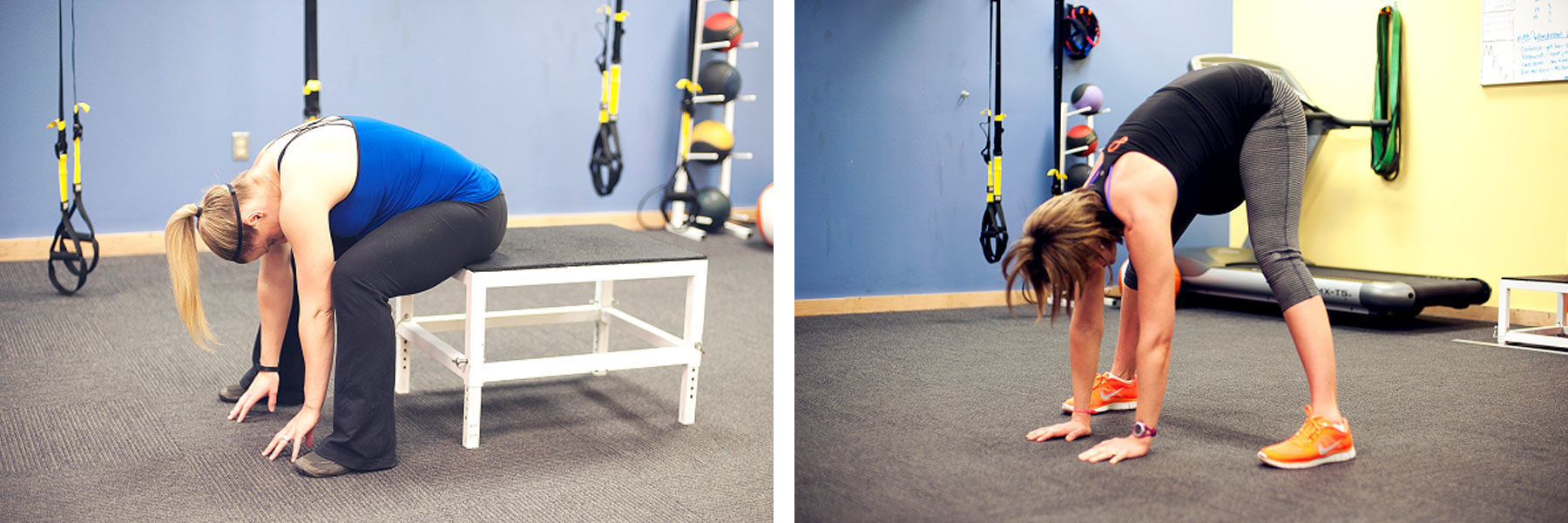
Due to the forced anterior pelvic tilt caused by increased weight in the belly, the lower back and hamstrings often tighten up.
To perform this exercise from a seated position, sit at the front of a chair with the feet flat on the ground. Separate the knees and bend at the waist.
To perform this exercise from a standing position, bend the knees and position the legs a comfortable distance apart. Lower the hands to the floor or a step. Slowly begin to lift the tailbone toward the ceiling while straightening the legs. Stop once a stretch is felt.
Standing Scapular Retraction With a Foam Roller
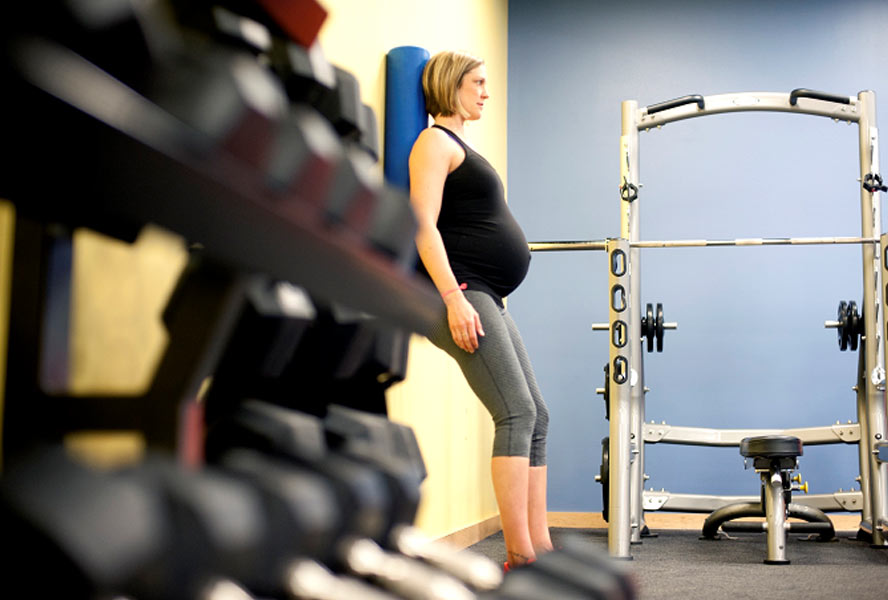
Increased lumbar lordosis also leads to a kyphotic posture in the thoracic spine. This posture can be somewhat alleviated by strengthening the muscles in the upper back.
Place a 3-foot foam roller up against a wall and stand facing away from it. Bend the knees slightly and place the tailbone onto the roller. Continue aligning the back on the roller so that an imprint is felt on the spine. Gently (not forcefully) hug the foam roller with the scapula and hold for one minute.
Pelvic Tilts (Supine or Standing)
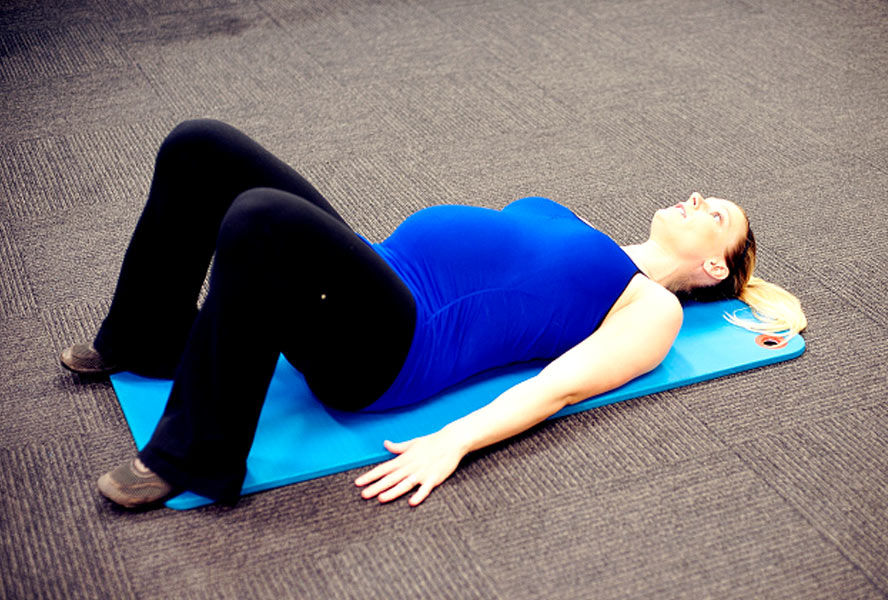
Pelvic tilts are another great exercise for alleviating low-back pain. This move also strengthens the abdominals while stretching the tight lower-back muscles.
Begin lying supine on the ground or standing against a wall with knees slightly bent. Gently tighten the glutes and belly muscles and shift the pelvis posteriorly. This should flatten the curve in the lower back and create an imprint on the mat or wall. Hold for six seconds and repeat. This exercise can also be performed from a seated or quadruped position, or while siting on a stability ball. (Note: If performing this exercise in the supine position, avoid holding it for longer than 30 seconds. Have the exerciser roll to her left side between sets.)
Side-lying Clam Shell
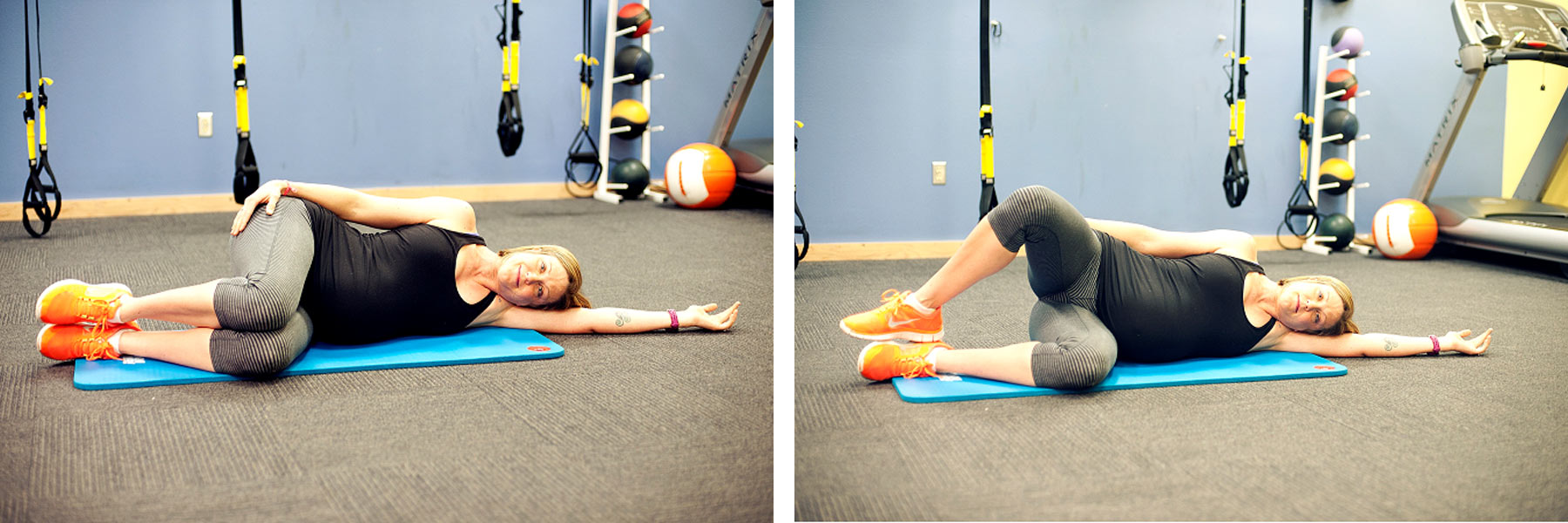
With the increased anterior pelvic tilt, the glutes and hips are weakened due to an over-tightening of the hip flexors. Strengthening the gluteus medius and minimus helps stabilize the sacroiliac joint, which can become loosened and unstable during pregnancy. This is a great exercise to do in between supine exercises as it only takes a quick roll to the side.
Begin in a side-lying position with the pelvis perpendicular to the floor. Knees should be bent between 45 and 90 degrees. Brace the core and keep the feet together. Contract the glutes and lift the top knee off of the bottom knee. Stop before the pelvis moves or the hips roll back. Hold for five to 10 seconds and repeat.
Assisted Lunges

Again, strengthening the glutes is important to help stabilize the hips and improve posture during pregnancy. Assisted lunges are also great for improving both balance and leg strength. As pregnancy progresses, a woman typically gains more weight and her joints become more lax, which can make lunges more difficult. Lunges can be unloaded using a suspension trainer or by placing a BOSU ball under the back knee. While returning to a stand with each lunge, ensure the glutes are engaged by thinking of scissoring the legs together, helping to preserve proper posture and glute engagement.
For more information on how to work with prenatal clients, check out the ACE Pre and Postnatal Fitness course.




 by
by 




 by
by